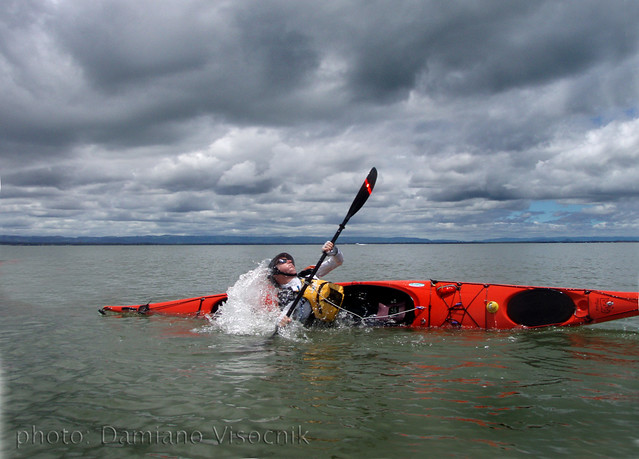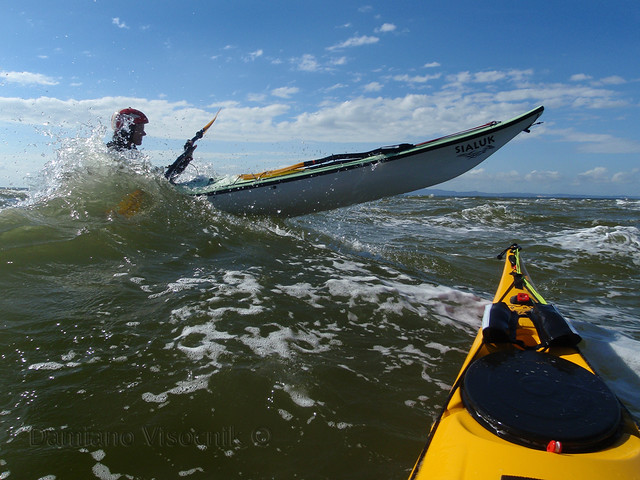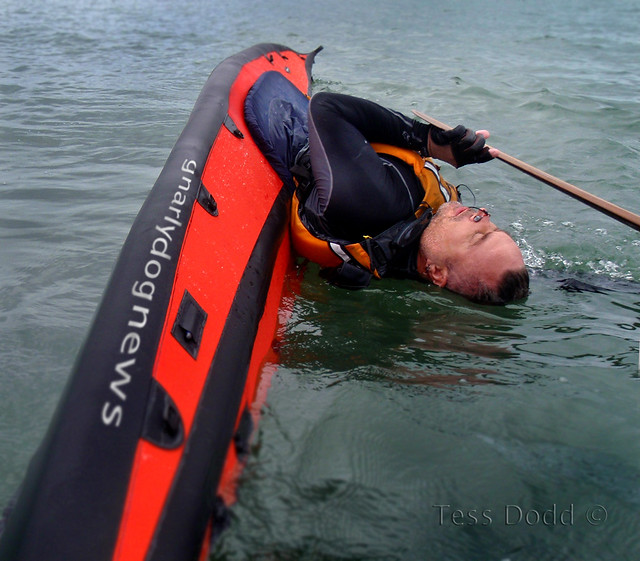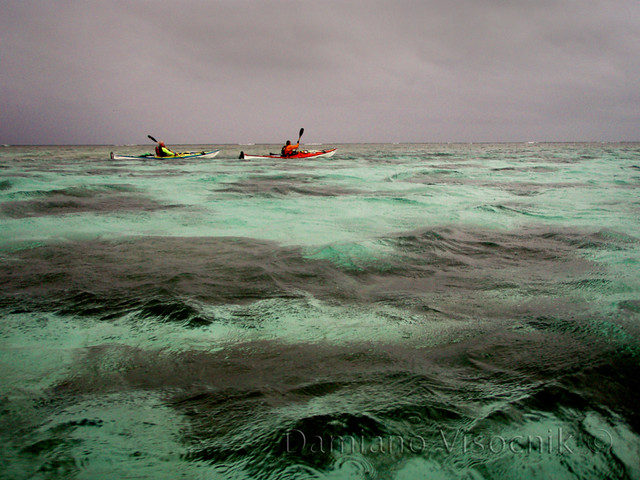So many paddlers regard the ability to roll the holy grail of sea kayaking.
I was one of them. I envied paddlers that could roll a kayak; it just looked so cool.
I will see them plop-in purposely and turn their kayaks upside down only to see them explode a few seconds later out the water with a mighty splash and be back up. Sometimes spectators would even clap :-)

At the time I felt that there was a lot of mysticism around rolling and not many in my circles really knew how to roll; I had to learn how to roll.
I took several lessons and I paid instructors to teach me how to roll. Several months passed and many pool session later I was still struggling.
However not knowing how to roll did not deter me from going out at sea even if admittedly in a wide bay where waves don’t really reach much over a meter. I rarely fell in and I always paddled with others so I could be helped back into my kayak.
Trying to self rescue was not that pretty: I felt very unbalanced when trying to “cowboy scramble” into my relatively wide (56-58cm) kayak. They tell me it has something to do with being top heavy and a bit taller than the average paddlers; I think it’s poor balance.

On the other hand I would also see my paddling buddies having a much easier time getting back in their kayak. We would regularly hit the surf zone and on days when the waves were not really pounding we were gaining solid skills. I would push myself and try to catch the steeper waves. I would regularly broach, often tip and end up out of my kayak. I also broke several rudders and realized that those pesky metal bits on the stern are not surf friendly; eventually I opted for skeg kayaks.

I had no chance to re-enter my kayak on my own while the water was bumpy, not necessarily breaking waves but still dynamic enough to toss my kayak around a bit. I needed help to re-enter or swim a long way back to the beach pulling my flooded kayak behind me. I was getting tired quickly as where my paddle buddies of my clumsiness.
Now I really needed to learn how to roll coz on a bad day the surf was bringing more frustration than joy. There were some among us tho that could jump back in the kayak with very little fuss: a few seconds and they would be out of the water with a single big leap, plopping their butt into the seat, legs sticking out on the side to then bring them in one at the time through the keyhole cockpit.
I could not do that: I am just too big and slow. What I wanted was the sense of security of knowing how to get into the kayak in lumpy waters.

While paddle floats would work relatively well for me in calm waters I found them useless in conditions that made me tip in the first place.
Relying on my paddling buddies was unfair and probably short sighted as on some of our trips we were not always very close to each other.
What I did have to my advantage is the water temperature that I paddle on.
All of my paddling was in subtropical seas where on a cold winter day I would "gasp" at 17C immersions. I feel totally different if I would have to deal with water that saps paddlers' energy in times of a capsize. I rarely wear more than just a light paddling top and never insulation paddling garments.
In winter I have to protect from evaporative cooling wind more than immersion.
I persisted with leaning to roll and eventually a skilled instructor thaught me the finesse of rolling.
I loved my new found skills and practiced a lot. I also discovered that rolling is not about the explosive power that a paddle might offer but is more about a blend of skills from being able to turn the boat with my body aided by the gentle support of my paddle.
I still remember Craig McSween saying: you should learn to scull first before you roll.

Only now do I understand what he meant: sculling is the real roll for me where I can have a better chance of righting my capsized kayak in aerated water and windy wave conditions.
Is rolling really essential?
I am sure it is for me but I would not evangelically preach it to everybody.
As I witnessed many times paddlers recovering from a wet exit in the surf zone I now believe that rolling is not the holy grail, in Queensland waters.
If one can re-enter his/her kayak swiftly in all conditions and be able to empty a flooded cockpit in bumpy seas then rolling is not critical. If waters were much colder than I would think differently.
I still advocate to gain the best skills possible but there are many ways one can self rescue.
As long as a paddler can reliably get out of trouble in demanding conditions (I don't count calm waters one of them) then there is validity in the alternatives.

Jim on UK Forum puts it so well:
Rolling can be over-rated, far more important is having the skill not to fall in, BUT almost everyone finds it much easier to develop those skills after they can roll, because the ability to roll gives them more confidence to practice recoveries....



I agree there are good alternatives to rolling, especially in mild climate but I think a kayaker should seek fun also in this activity.
ReplyDeleteI think that rolling is not really physically demanding, it is more a mental ability
To make a simple example consider swimming: if you are not able to swim you will sink even if powerful and fighting with all your force; on the other hand, if you know how to swim and you are relaxed, this activity will take very less effort, good also if you are old and/or not fit
People loving water will love swimming...and if they don't, most of the time is simply some fear or bad experience, the effort to go beyond this initial block is worth and will bring a lot of fun later.
I would always suggest to take this approach also to rolling.
Ciao
Alessandro
I am not a natural "water person" and it took a while getting used to fall in and not be worried. These days I regard rolling as a fun thing to do, not just as a rescue method.
DeleteRolling ... some days I only have to think about rolling and I'm up ... other days, well we all know about "other days" ...
ReplyDeleteWhat boat are you paddling in the sculling shot? Looks like a folding boat ...
it's a Folbot Cooper; not ideal for layback rolling. I have since modified the rib behind the cockpit and brought the deck much lower preventing my back from hitting the coaming. I got the idea from Dubside where he removed the rib completely from his Katzalano. I just reconfigured mine and lowered it.
DeleteGreat post. I am in the throes of an extended learning phase. Sometimes it all comes together and I am up quite effortlessly, other days it takes a lot of attempts to get one successful roll. It's some how comforting that other folks have had an extended learning period too. In the end, the great thing about sea kayaking is that you can always learn something new.
ReplyDeleteSandy, I can sympathise with you about not getting it all the time. The day I learned how to scull it all slowly melted away and my "fails" became simply prolonged sculls instead of a single sweep to roll back up. If my form is out I rush and force my roll to then feel it's lousy, so I roll back over and start with a basic hand position close to shoulder/face and scull up. A few minutes later and my rolls are usually back to good form. I have observed the same with the few people I have helped with rolling: if their roll is off they go back to a few minutes of sculling and things improve immediately. I believe it's worth trying.
DeleteHi Gnarly. Good commentary. As a keen paddler in your own Moreton Bay I agree with your view that warmer waters make the choice of learning to roll less vital. Warmer waters also mean that there are far less excuses for NOT learning to roll. I have never enjoyed my kayaking more since learning and having confidence in my ability to roll if the unthinkable happened. And yes, it is also great fun when you have it squared away. Peter
ReplyDeletePeter, I have observed a marked improvement in confidence and "pushing the comfort limit" since you have been rolling solidly. Our warm waters allow us to practice in the real conditions from the very start, without having to do heated pool sessions like our Northern hemisphere cousins (or those few unfortunate Taswegians). No wetsuit or drysuit, just a nose clip or goggles.
DeleteWill, thank you for your thoughts and no need to apologies for your contribution to the discussion.
DeleteMy philosophy is very close to yours: rolling does expand the horizon and instils confidence for self reliance.
However I am sure you are aware that in life there are drivers and passengers; not everybody has the confidence to be a driver and capable of making sound decisions to then own the consequences. When I used to be in a Club and lead trips some individuals had too high of an expectations from me to the point of blaming me if the conditions were deteriorating. Needless to say those individuals never acquired the skills to be self reliant but prefer the pack mentality.
On the other hand I know of a few paddlers that have done some serious trips in the ocean in rough conditions and never learned how to roll. They are however capable of skilfully re-enter a kayak with speed (not talking paddle float here!) in rough conditions. I agree with you about the false sense of security of practicing rescues only in calm conditions too; what good is that?
Finally, what can I say to a paddlers that tells me: I have been paddling for 15 years and never capsized, so why should I learn how to self rescue?
I also know that person only paddles in calm conditions and starts to worry if the wind picks up above 10 knots....
Very good blogpost. I'm looking forward to the day I have a bomb proof roll.
ReplyDeleteI totally agree with Will in his analysis and discussion. Personally I also feel that each paddler is ultimately responsible for his own safety and cannot blame anybody if they dont have the skill to survive the conditions they choose to go out in. As for rolling, learn to roll , roll a lot in all conditions and your enjoyment of this great sport will grow by leaps and bounds.
ReplyDelete